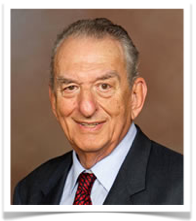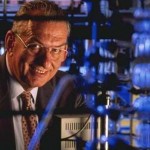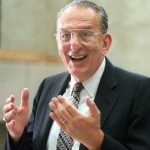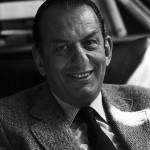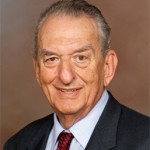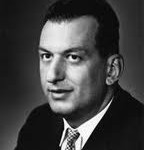George Andrew Olah (born in 1927, ) is a Hungarian and Americal chemist. He was awarded with the Nobel Prize in Chemistry 1994 for his work involving generation and reactivity of carbocations via superacids. Olah developed methods for increasing the intermediate phase of rapid hydrocarbon reactions. During his work Olah found out that introduction of very strong acids can preserve the carbocations for long periods. Olah’s work led to the mass production of synthesized high octane gasoline and it provided new ways for use of hydrocarbons by the petroleum industry.
-
Education and Experiences
1949 Ph.D. Organic Chemistry, Technical University Budapest, Hungary
1949 Assistant Professor of Organic Chemistry, Technical University, Budapest, Hungary
1954 Head of Department of Organic Chemistry and Associate Scientific Director, Central Research Institute of the Hungarian Academy of Sciences, Budapest, Hungary
1957 Research Scientist, Dow Chemical Company
1965 Professor and Chairman, Department of Chemistry, Western Reserve University, Cleveland
1967 Chairman of combined Departments of Chemistry, Case Institute of Technology; Case Western Reserve University
1967 C.F. Mabery Distinguished Professor of Research in Chemistry, Case Western Reserve University
1977 Professor of Chemistry and Scientific Director, Hydrocarbon Research Institute, University of Southern California
1980 Distinguished Professor and Donald P. and Katherine B. Loker Chair in Organic Chemistry, University of Southern California
1991 Director, Loker Hydrocarbon Research Institute, University of Southern California
2008 Distinguished Professor of School of Engineering, University of Southern California
2010 Founding Director, Loker Hydrocarbon Research Institute, University of Southern California
-
Awards and Honors
1964 Recipient of National or International Prize in Discipline, American Chemical Society Award in Petroleum Chemistry
19767 Leo Hendrick Baekeland Award
1970 Recipient of National or International Prize in Discipline, Morley Medal
1972 Guggenheim Fellowship Recipient, Fellow of the J.S. Guggenheim Foundation
1974 Fellow of the Society for the Promotion of Science, Japan
1976b National Academy Member, Member of the U.S. National Academy of Sciences
1977 Centenary Lectureship, British Chemical Society
1979 Alexander von Humbolt Fellowship Recipient, Alexander von Humbolt-Stiftung Award for Senior U.S. Scientists
1985 USC Associates Award For Creativity In Research And Scholarship
1988 Honorary D.Sc. Honoris Causa, University of Durham, UK
1988 Guggenheim Fellowship Recipient
1989 Member, European Academy of Arts, Sciences & Humanities
1989 Honorary D.Sc., Technical University of Budapest
1990 Honorary Member, Hungarian Academy of Sciences
1990 Honorary D.Sc., University of Munich
1994 Nobel Prize Recipients, Chemistry
1996 Cotton Medal, American Chemical Society
2013 The 2013 Eric and Sheila Samson Prime Minister’s Prize for Innovation in Alternative Fuels for Transportation
2013 Semmelweis Budapest Award
-
Research
Magic Acid and Superacid Chemistry[1]: “Olah’s magic acid,” so-named for its ability to attack hydrocarbons, is prepared by mixing antimony pentafluoride (SbF5) and fluorosulfuric acid. While working at Dow, he discovered a way to preserve the intermediates and to allow their properties to be investigated. He found that solutions of a very strong acid, variously described as a ‘superacid’ or a ‘magic acid’, would preserve carbocations for months at a time and thus allow their structure to be determined with such techniques as NMR.
Non-Classical Carbocation: A carbocation the ground state of which has delocalized (bridged) bonding π- or σ-electrons. (N.B. Allylic and benzylic carbocations are not considered nonclassical.) And, they are displaying delocalization of sigma bonds in 3-center-2-electron bonds of bridged systems. For an example, norbornyl cation.
Weinstein and Olah were trying to explain a puzzling reaction of 2-norbornyl brosylate, in which the brosylate group can have an endo or exo position. A substitution reaction replacing brosylate with an acyl group gives the same product for both isomers: exo-2-norbornyl acetate – although the exo starting material reacts much faster.
In 1949, Winstein suggested a ‘non-classical’ cation, featuring a pair of delocalised electrons smeared between three carbon atoms, which helped the exo brosylate to leave and then favoured the exo product. It was a popular idea, and non-classical cations started popping up in papers throughout the 1950s.
From the early 1960s, though, Brown began a campaign against this exotic beast with its devilish five-coordinate carbon atoms. Why invoke a strange form of bonding over more conventional reasoning? Brown preferred a pair of classical trivalent carbocations that rapidly interconverted, and put the difference in reaction rates down to steric effects. In 1964, Olah’s NMR studies had convinced most chemists that Winstein was right.[2]
Methanol Economy:[3] In recent years, his research shifted from hydrocarbons and their transformation into fuel to the methanol economy. He is now with Robert Zubrin, Anne Korin, and James Woolsey in promoting a flexible-fuel mandate initiative.
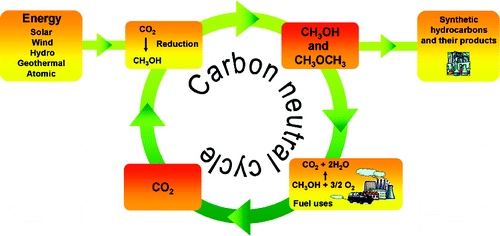
-
References
[1] Research Review: Olah, G. A. J. Org. Chem. 2005, 70, 2418. DOI:10.1021/jo040285o
[2] Schleyer, P. v. R.; Watts, W. E.; Fort, R. C.; Comisarow, M. B.; Olah, G. A. J. Am. Chem. Soc. 1964, 86, 5679. DOI:10.1021/ja01078a056
[3] (a) Olah, G. A. Angew. Chem. Int. Ed. 2005, 44, 2636. DOI:10.1002/anie.200462121
(b) “Chemical Recycling of Carbon Dioxide to Methanol and Dimethyl Ether: From Greenhouse Gas to Renewable, Environmentally Carbon Neutral Fuels and Synthetic Hydrocarbons”
Olah, G. A.; Prakash G. K. S.; Goeppert, A. J. Org. Chem. 2009, 74, 487. DOI:10.1021/jo801260f
Nature’s photosynthesis uses the sun’s energy with chlorophyll in plants as a catalyst to recycle carbon dioxide and water into new plant life. Only given sufficient geological time can new fossil fuels be formed naturally. In contrast, chemical recycling of carbon dioxide from natural and industrial sources as well as varied human activities or even from the air itself to methanol or dimethyl ether (DME) and their varied products can be achieved via its capture and subsequent reductive hydrogenative conversion. The present Perspective reviews this new approach and our research in the field over the last 15 years. Carbon recycling represents a significant aspect of our proposed Methanol Economy. Any available energy source (alternative energies such as solar, wind, geothermal, and atomic energy) can be used for the production of needed hydrogen and chemical conversion of CO2. Improved new methods for the efficient reductive conversion of CO2 to methanol and/or DME that we have developed include bireforming with methane and ways of catalytic or electrochemical conversions. Liquid methanol is preferable to highly volatile and potentially explosive hydrogen for energy storage and transportation. Together with the derived DME, they are excellent transportation fuels for internal combustion engines (ICE) and fuel cells as well as convenient starting materials for synthetic hydrocarbons and their varied products. Carbon dioxide thus can be chemically transformed from a detrimental greenhouse gas causing global warming into a valuable, renewable and inexhaustible carbon source of the future allowing environmentally neutral use of carbon fuels and derived hydrocarbon products.
(c)Methanol Economy – Wikipedia
-
Related Links
George A. Olah - Autobiography
George Olah at Unversity of Southern California
George Andrew Olah - Wikipedia
Magic Acid - Wikipedia
Carbocation - Wikipedia
Non-Classical ions - Wikipedia
-
Photo Gallery
-
Related Books
[amazonjs asin=”0471653152″ locale=”US” title=”Friedel-crafts Chemistry (Interscience monographs on organic chemistry)”][amazonjs asin=”3527324224″ locale=”US” title=”Beyond Oil and Gas: The Methanol Economy”][amazonjs asin=”9810227698″ locale=”US” title=”Across Conventional Lines: Selected Papers of George A Olah (in 2 Vols)”][amazonjs asin=”0471543705″ locale=”US” title=”Synthetic Fluorine Chemistry”]

